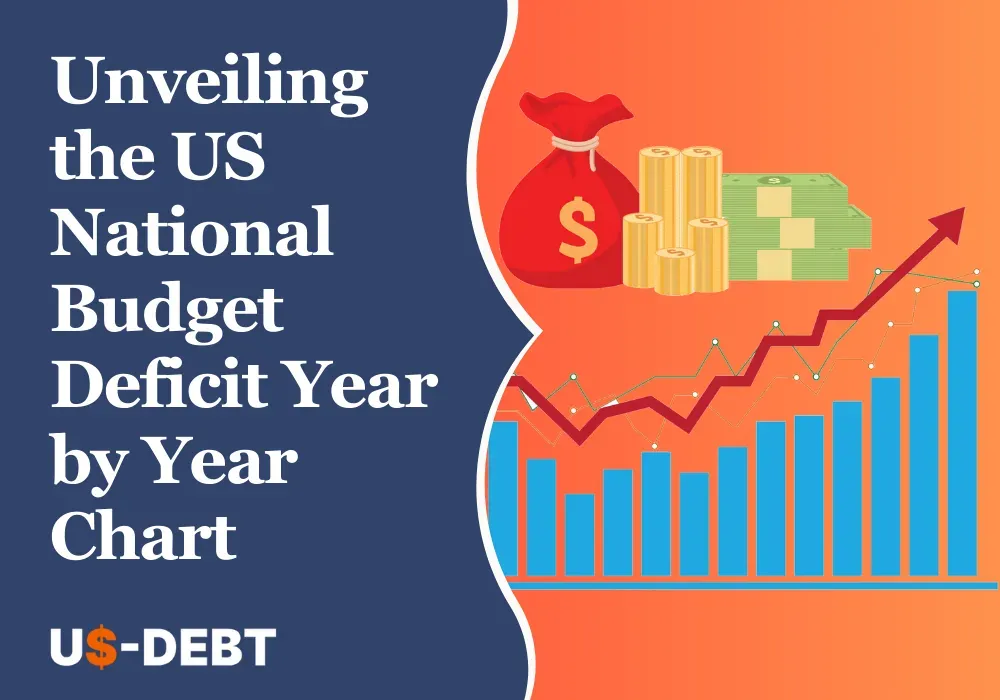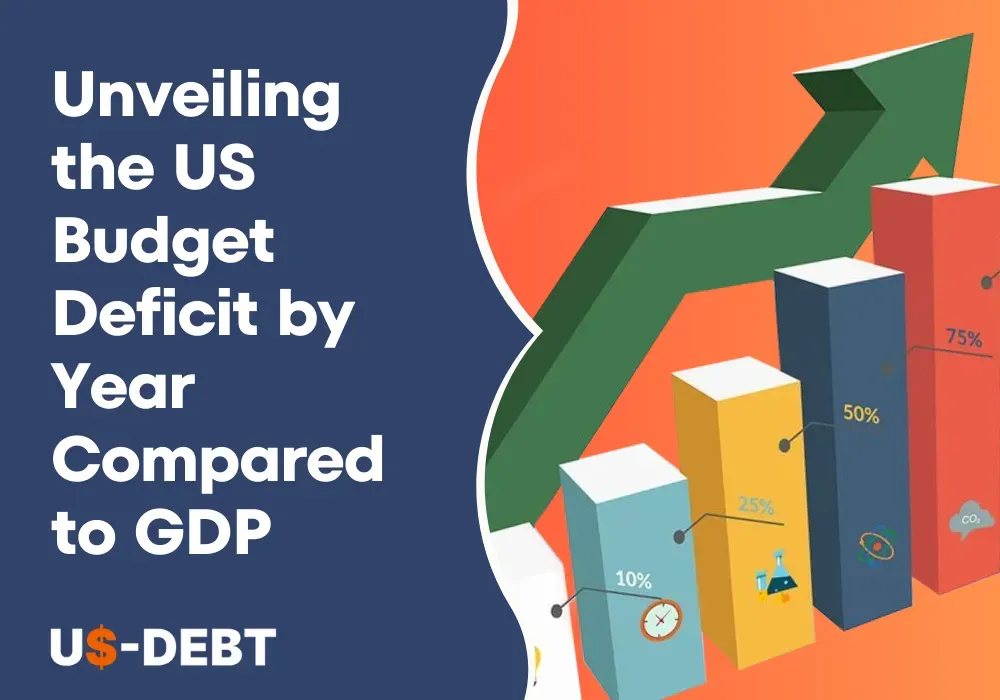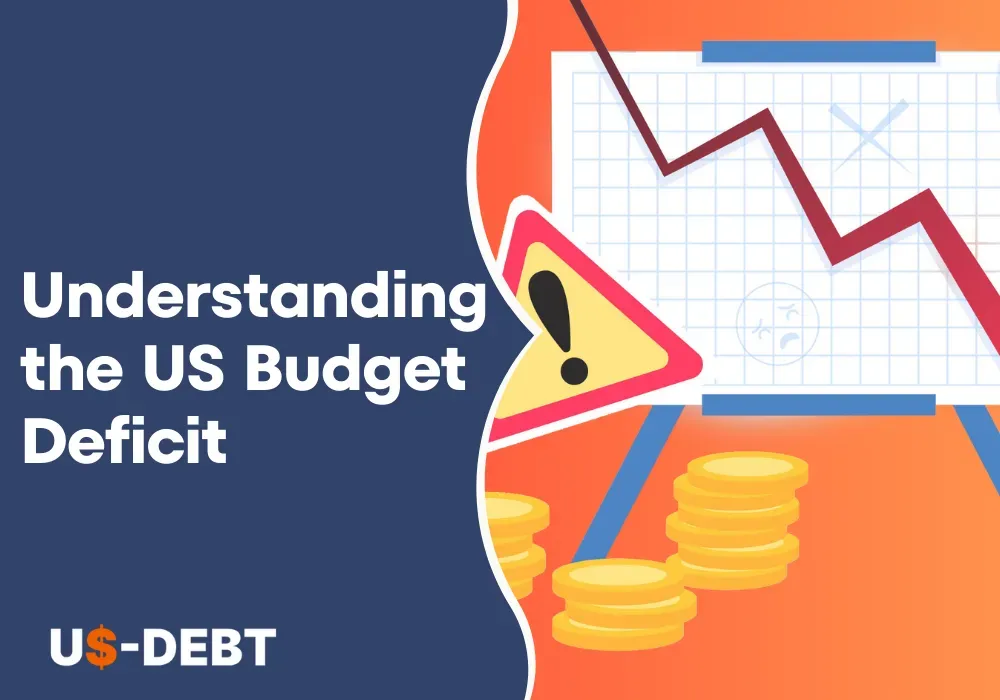In venturing upon this deep expedition, our foremost objective is to furnish you with a profound grasp of the complicated enigma that is the US National Budget Deficit. As you traverse the spectrum of this blog post, you will not only assimilate a profound comprehension of this intricate fiscal phenomenon but also acquire the adeptness to partake in educated discussions concerning the economic well-being of our nation.
Â
Introduction to the US National Budget Deficit
In the complex landscape of national economics, one term often echoes with both concern and curiosity: the U.S. National Budget Deficit. It's a phrase that carries substantial weight, sparking debates and discussions across the nation.
Â
Explanation of the US National Budget Deficit
At its essence, the Fiscal Deficit of the United States delves into the financial abyss that emerges when the government spends beyond its revenue harvest in a given fiscal period. It doesn't just display a discrepancy within the financial ledger; instead, it stands as a pivotal gauge of a nation's fiscal well-being. Comprehending the intricacies of this deficit is paramount, for it operates as a litmus test for evaluating economic strategies, governmental priorities, and the overarching financial robustness of the nation.
Â
Significance and Impact of Budget Deficits
The significance of fiscal shortfalls transcends mere ledger entries. It assumes a pivotal role in sculpting the economic terrain, exerting influence over a spectrum ranging from interest rates to inflation. The reverberations of fiscal shortfalls radiate across society, impacting individuals, enterprises, and even the governmental apparatus itself.
Â
Historical Overview of the US National Budget Deficit
Â
Early Budget Deficits in American History
The United States first incurred debt in the century following Alexander Hamilton's repayment of Revolutionary War obligations with a federal debt to finance its wars. However, in the 1930s, the Roosevelt administration made an effort to use government borrowing to help the country recover from the Great Depression.
The sheer magnitude of the federal debt's cumulative growth becomes apparent when expressed in monetary terms. When delving into the depths of historical debt, the year 1900 may initially appear inconspicuous amid the tapestry of the past century. Nonetheless, its profound impact on the contemporary economic terrain becomes remarkably evident when we compare it to the continually evolving trajectory of GDP.
In the chronicles of American fiscal history, Alexander Hamilton, the inaugural Secretary of the Treasury, fastidiously established the groundwork for the burgeoning national indebtedness during the tumultuous and transformative epoch of the 1790s. Hamilton, a luminary in the intricate world of banking, meticulously choreographed the restructuring of the liabilities amassed by individual states throughout the tempestuous Revolutionary War, transmuting them into responsibilities shouldered by the burgeoning federal government. This shrewd stratagem not only bestowed fiscal equilibrium upon the burgeoning nation but also expedited the settlement of the accumulated obligations.
Financial responsibilities were envisaged to be sustained through the allocation of federal resources, earmarked for both the principal redemption and interest disbursements. Henceforth, the country's fiscal burden, relative to its Gross Domestic Product (GDP), rested at 35%. This fortunate financial stability was fortuitously attained just before the onset of the Civil War.
Amid this turbulent era, government indebtedness once more escalated, cresting at 33% of the nation's economic output. Astonishingly, the outstanding debts from the Revolutionary War were completely settled by the 1830s, marking a pivotal juncture in the nation's fiscal history. Nonetheless, as the 20th century commenced, the liabilities stemming from the Civil War had been significantly liquidated.
Fiscal Year | Deficit in Billions ($) | Deficit-to-GDP Ratio |
1960 | $0 | -0.10% |
1961 | $3 | 0.60% |
1962 | $7 | 1.20% |
1963 | $5 | 0.70% |
1964 | $6 | 0.90% |
1965 | $1 | 0.20% |
1966 | $4 | 0.50% |
1967 | $9 | 1.00% |
1968 | $25 | 2.70% |
1969 | ($3) | -0.30% |
1970 | $3 | 0.30% |
1971 | $23 | 2.00% |
1972 | $23 | 1.80% |
1973 | $15 | 1.00% |
1974 | $6 | 0.40% |
1975 | $53 | 3.20% |
1976 | $74 | 3.90% |
1977 | $54 | 2.60% |
1978 | $59 | 2.50% |
1979 | $41 | 1.60% |
1980 | $74 | 2.60% |
1981 | $79 | 2.50% |
1982 | $128 | 3.80% |
1983 | $208 | 5.70% |
1984 | $185 | 4.60% |
1985 | $212 | 4.90% |
1986 | $221 | 4.80% |
1987 | $150 | 3.10% |
1988 | $155 | 3.00% |
1989 | $153 | 2.70% |
1990 | $221 | 3.70% |
1991 | $269 | 4.40% |
1992 | $290 | 4.50% |
1993 | $255 | 3.70% |
1994 | $203 | 2.80% |
1995 | $164 | 2.10% |
1996 | $107 | 1.30% |
1997 | $22 | 0.30% |
1998 | ($69) | -0.80% |
1999 | ($126) | -1.30% |
2000 | ($236) | -2.30% |
2001 | ($128) | -1.20% |
2002 | $158 | 1.40% |
2003 | $378 | 3.30% |
2004 | $413 | 3.40% |
2005 | $318 | 2.40% |
2006 | $248 | 1.80% |
Source: The Balance Money
Â
Key Events Shaping Budget Deficits in the 20th Century
Inception in the early 20th century witnessed the amalgamated indebtedness of federal and local governments amounting to a mere fraction, constituting less than 20% of the Gross Domestic Product (GDP). The debt held by states remained at judicious levels. Nevertheless, after the culmination of World War I, the federal debt embarked on an astronomic ascent, skyrocketing to 32% of the GDP. Simultaneously, during the mid-1920s, state and municipal debts had been projected to confine 16% of the GDP, while the federal debt declined to subsume the 20% threshold.
In 1933, amid the Great Depression, President Hoover's approach of heavy spending escalated government debt to 39.4% of GDP, with state and local levels also burdened, reaching 5% and 28% of GDP, respectively. In the annals of history, this epoch bore witness to an astounding cumulative government indebtedness, amounting to an imposing 70% of the Gross Domestic Product, manifesting the fiscal tumultuousness of the era.
During the era presided over by President Roosevelt, the national fiscal responsibilities initially surged to a formidable 70% of the Gross Domestic Product in 1933, only to steadily improve and decrease to 49% by the dawn of 1940. Interestingly, the state's financial burdens experienced a significant reduction, dwindling to a mere 3.5% of the Gross Domestic Product, while the municipal financial obligations saw a remarkable decline, plunging to a modest 16.2% of the Gross Domestic Product by the year 1940. These fiscal shifts reflected a complex interplay of economic factors during that era.
However, the US entered new debt territory during World War II. Federal debt rapidly increased from 45 percent of GDP in 1941 to nearly 119 percent of GDP in 1946 after the war, with state and local debt contributing another 7 percent. For the following 35 years, successive administrations reduced the debt, but then Ronald Reagan took office. In the pursuit of victory during the Cold War, he took bold measures, causing the national debt to surge, reaching an astounding 50% of the GDP.
In the pursuit of countering the battle against terrorism and strengthening the resilience of financial institutions, President Bush enacted policies that precipitated an unparalleled upsurge in the nation's fiscal indebtedness. As of the year 2016, the amassed fiscal liabilities, spanning federal, state, and local tiers, had surged considerably, eclipsing the threshold of 120% of the Gross Domestic Product (GDP). This escalation in fiscal obligations was a direct outcome of President Obama's unwavering endeavors to rejuvenate the economy in the aftermath of the tumultuous financial crisis of 2008. Then COVID arrived. Federal, state, and local debt combined were predicted to be 134.2 percent of GDP in 2022.
Fiscal Year | Deficit in Billions ($) | Deficit-to-GDP Ratio |
2007 | $161 | 1.10% |
2008 | $459 | 3.10% |
2009 | $1,413 | 9.80% |
2010 | $1,294 | 8.60% |
2011 | $1,300 | 8.30% |
2012 | $1,077 | 6.60% |
2013 | $680 | 4.00% |
2014 | $485 | 2.80% |
2015 | $442 | 2.40% |
2016 | $585 | 3.10% |
2017 | $665 | 3.40% |
2018 | $779 | 3.80% |
2019 | $984 | 4.60% |
2020 | $3,132 | 15.00% |
2021 | $2,772 | 12.10% |
Source: The Balance Money
Â
Understanding Budget Surpluses and Deficits
Understanding the intricacies of the US National Budget Deficit is essential for every citizen. A budget deficit occurs when the government's expenditures exceed its revenues within a fiscal year. Conversely, a budget surplus arises when revenues surpass expenditures. These figures, expressed in billions or trillions, have significant implications for the nation's economic health.
Â
Differentiating Budget Surpluses and Deficits
To differentiate between budget surpluses and deficits, it's vital to grasp their contrasting effects on the economy. Budget surplus is the term when the government is making more money than it is spending, which results in a decrease in the national debt. This is an indication of smart financial management. On the other hand, a budget deficit shows that the government is borrowing to pay for expenses, which could raise the level of the national debt.
Â
Factors Influencing Budget Balances
The US National Budget Deficit isn't solely determined by government spending and taxation. Various factors influence these balances year by year. Recession and growth in the economy have an impact on tax collections and the requirement for government spending. In addition, policy choices like tax cuts or higher military spending have a big impact on the budget.
Â
How Budget Deficits are Calculated?
Calculating the US National Budget Deficit involves meticulous accounting and monitoring of government income and expenses. It begins with tallying all revenue sources, including taxes, tariffs, and investments. Then, the government adds up its expenditures, encompassing areas like defense, healthcare, and social programs. The budget deficit is simply the difference between these two figures. Regular updates and meticulous record-keeping are vital for tracking the deficit year by year.
Mathematically, Budget Deficit = Total Expenditures by the Government â Total Income of the Government
Â
Analyzing U.S. Budget Deficits by Decades
Â
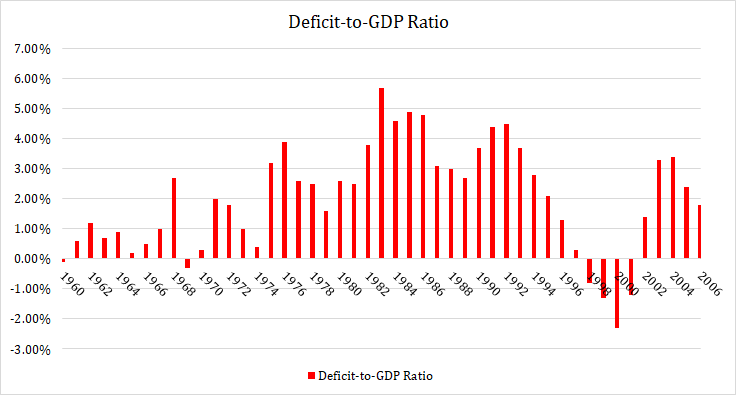
Â
1960s - The Kennedy and Johnson Era
The 1960s marked a significant turning point in the annals of American history. This transformative era wasn't solely about cultural and political shifts but also entailed a momentous evolution in the nation's fiscal landscape. During this period, the US National Budget Deficit underwent a turbulent journey, prominently characterized by the administrations of John F. Kennedy and Lyndon B. Johnson.
Kennedy's fiscal strategies initially aimed at jumpstarting economic expansion, which inadvertently led to fiscal deficits. However, as the decade unfolded, Johnson's ambitious "Great Society" initiatives and the escalating Vietnam War propelled government expenditures to new heights, exacerbating the burgeoning deficits. To fathom the intricacies of the budget deficit during the 1960s, one must delve into the intricacies of these influential policy shifts.
Â
1980s - Reaganomics and the Cold War
In the 1980s, the era was dominated by the presidency of Ronald Reagan, and his economic strategies famously referred to as "Reaganomics," left an indelible mark on the fiscal landscape. This period witnessed a profound transformation in the United States National Budget Deficit. Reagan's primary focus on tax abatements, the relaxation of regulatory constraints, and a substantial upsurge in military expenditures were designed to galvanize economic expansion.
However, these initiatives concurrently precipitated substantial deficits in the national budget. The persistent Cold War tensions with the Soviet Union further exacerbated the financial strain. A meticulous examination of the budgetary shortfall during the 1980s necessitates a comprehensive exploration of the repercussions of Reagan's policies and their enduring economic implications.
Â
2000s - The Dotcom Bubble and 9/11
In the early 2000s, the United States confronted distinctive economic intricacies. The decade was inaugurated with the abrupt deflation of the Dotcom bubble, an occurrence that reverberated through the technological markets and cast profound ramifications on government fiscal inflows. Nevertheless, the pivotal juncture of this epoch was the catastrophic terrorist onslaught on September 11, 2001.
In retaliation, the United States initiated the War on Terror, incurring substantial outlays in military resources. The financial aspect of the nation, encapsulated within the US National Budget Deficit, oscillated in response to these seminal incidents. Hence, it becomes imperative to scrutinize the extent to which these variables exerted influence over the economic topography throughout this interval.
Â
Recent Trends in the US Budget Deficits
Â
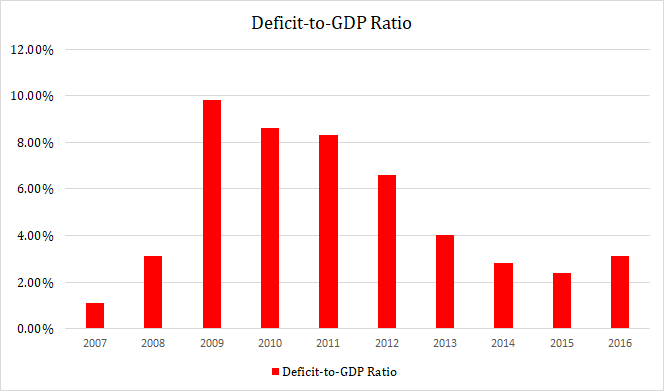
Â
The Great Recession (2007-2009)
During the Great Recession, spanning 2007 to 2009, the US National Budget Deficit was significantly impacted. This economic crisis resulted from the housing bubble's burst and the subsequent financial turmoil. The economy contracted, unemployment rates surged, tax revenues declined, and government expenditures increased due to stimulus measures and financial sector bailouts.
Consequently, the budget deficit expanded substantially during this period. Examining this deficit provides insights into the government's response to economic crises. The recession left a lasting mark on the nation's financial landscape, with profound consequences for the budget deficit. Analyzing these intricate dynamics offers a deeper understanding of the government's strategies in times of economic turmoil.
Â
The COVID-19 Pandemic (2020-2021)
Amidst the global upheaval of 2020, triggered by the COVID-19 pandemic, the United States National Fiscal Deficit encountered unparalleled trials. In an endeavor to alleviate the pandemic's economic repercussions, the government executed substantial relief initiatives, encompassing disbursements such as stimulus disbursements and the expansion of unemployment benefits.
These fiscal outlays, combined with dwindling tax revenues resulting from lockdowns and diminished economic vigor, yielded a noteworthy augmentation of the fiscal deficit. Scrutinizing the ramifications of the COVID-19 pandemic on the fiscal deficit underscores the pivotal role of governmental intervention in moments of turmoil.
Â
Current State of the US Budget Deficit
In the current fiscal year, the cumulative deficit has skyrocketed, surpassing the previous year's deficit by $887 billion due to unique timing factors. Specifically, in 2022, October 1 fell on a weekend, causing certain federal payments to be shifted into September of that year, thus reducing this year's outlays by $63 billion. Excluding this timing adjustment, the deficit for FY23 would be an astounding $950 billion higher than the previous year's total.
Over the first ten months of FY23, total outlays have reached an astonishing $5.3 trillion, marking an extraordinary increase of $471 billion compared to the same period in the preceding year, without considering timing shifts.
Â
Importance of Tracking Budget Deficits
Understanding the US National Budget Deficit is crucial for citizens and policymakers. It reflects the balance between government spending and revenue, affecting interest rates, inflation, and economic stability. Monitoring it informs smart financial decisions.
Â
Economic Implications of Budget Deficits
The intricate ramifications of fiscal deficits encompass a multitude of dimensions that ripple through the economic fabric. When a government consistently incurs deficits, it may necessitate borrowing funds, thereby engendering an escalation in the national debt. This, in its wake, can exert influence over interest rates, potentially encroaching upon private investment opportunities.
Furthermore, budgetary deficits hold the capacity to exert profound effects on the valuation of the national currency, culminating in fluctuations within exchange rates. A comprehensive comprehension of these implications stands as an imperative prerequisite for assessing the enduring repercussions of fiscal policies on the economic landscape.
Â
Fiscal Policy and Budget Management
Fiscal policy plays a pivotal role in managing budget deficits. Governments can implement various strategies, such as tax adjustments and expenditure controls, to influence the deficit's size. The challenge lies in striking a balance between stimulating economic growth and maintaining fiscal responsibility. Effective budget management requires a nuanced understanding of economic conditions and the ability to adapt policies as needed to ensure the budget remains in check.
Â
Role of Government Spending
The complex interplay of government expenditures significantly shapes the US National Budget Deficit, touching on various sectors from defense to healthcare and infrastructure. These financial decisions directly influence the budget's bottom line, shedding light on governmental priorities and policies. Examining government spending concerning the deficit reveals the government's underlying principles and emphasizes the need for careful resource allocation to achieve both short-term and long-term fiscal sustainability.
Â
Political Landscape and Budget Deficits
The US National Budget Deficit is deeply intertwined with the political landscape, as political decisions significantly influence fiscal policy. Understanding this relationship is crucial for citizens and policymakers. Budget deficits can fluctuate based on the priorities and economic philosophies of political parties in power. These deficits are a reflection of how the government chooses to allocate resources and whether it prioritizes fiscal restraint or stimulus measures.
Â
Partisan Perspectives on Budget Management
Partisan perspectives on budget management vary widely and are often shaped by differing ideologies. For instance, certain political parties may support cutting spending and exercising fiscal restraint while highlighting the significance of a balanced budget. Others may contend that via government expenditure, deficits can be used to boost the economy. Analyzing these partisan viewpoints provides insight into the ongoing debates surrounding budget management.
Â
Role of Congress and the Executive Branch
The result of cooperation between Congress and the Executive Branch is the US National Budget Deficit. Through the budgeting process, Congress, which possesses the power of the purse, authorizes government spending. By putting up a budget proposal and either signing or vetoing expenditure laws, the President plays a crucial role. Understanding the dynamics between these branches of government and their influence on budget deficits is essential for comprehending the complexities of fiscal policy.
Â
Political Implications of Budget Deficits
Budget deficits have significant political implications, impacting public opinion, elections, and policy decisions. High deficits can lead to debates over fiscal responsibility, while low deficits may be seen as a sign of prudent governance. Moreover, budget deficits can shape political agendas, with parties and candidates offering different solutions for addressing them. Examining these political implications sheds light on how budget deficits are woven into the fabric of American politics.
Â
Public Opinion on Budget Deficits
Public opinion plays a vital role in shaping the discussion surrounding the US National Budget Deficit. People's opinions on deficits might differ greatly, depending on their economic situation, political convictions, and how they regard government spending. Understanding the range of public opinion is essential to understanding the larger conversation on fiscal policy.
Â
Public Awareness and Concerns
Public awareness of budget deficits and their concerns about them can fluctuate over time. During periods of economic turmoil or when deficits become prominent in the media, public concern may increase. Conversely, when the economy is stable, these concerns may wane. Analyzing these fluctuations in public awareness and concerns helps gauge the level of attention deficits receive.
Â
Surveys and Polls on Budget Priorities
Surveys and polls are essential tools for gauging public sentiment on budget priorities. These instruments delve into questions about tax policies, government spending, and budget deficits. The results provide valuable insights into what the public values in terms of fiscal policy and where they believe resources should be allocated.
Â
Influence of Public Opinion on Policy
Public opinion on the US National Budget Deficit can significantly influence policy decisions. Elected authorities frequently consider public opinion when making choices regarding fiscal issues. Voters' worries about deficits may affect policy choices, possibly resulting in more economically responsible choices. However, significant public support for specific government initiatives may result in higher spending, which may impact the deficit.
Â
How-to Questions Related to Federal Budget Deficit
Â
How Does the Government Finance Budget Deficits?
The government has several methods to finance budget deficits. One common approach is borrowing through the issuance of government bonds. These bonds are offered to domestic and international investors who lend money to the government with the guarantee of interest-bearing payback. Another approach is using Federal Reserve short-term loans. Additionally, the government can generate revenue by selling assets or increasing taxes.
Â
How Can Budget Deficits Be Reduced or Eliminated?
Reducing or eliminating budget deficits often involves a combination of fiscal policies. This may entail cutting back on specific government spending, raising taxes, putting austerity measures in place, and pursuing economic growth methods. Depending on the political and economic situation, different strategies are used.
Â
How Do Budget Deficits Affect the National Debt?
The national debt is increased by budget deficits since they represent the accumulation of prior deficits. The national debt rises when the government continuously incurs deficits and must borrow to pay its expenses. The key to managing and gradually lowering the national debt is to address budget deficits.
Â
How Do Budget Deficits Impact Inflation?
Budget deficits can influence inflation, albeit indirectly. If the government finances deficits by printing more money or increasing the money supply excessively, it can lead to inflation. However, moderate deficits that are financed through borrowing typically have a less direct impact on inflation. Budget deficits and inflation have a complicated relationship that depends on several economic variables.
Â
How Do Other Countries Manage Their Budget Deficits?
Countries around the world employ various strategies to manage budget deficits. These tactics could include fiscal stabilization through spending reductions or tax increases, recessionary economic stimulation, and structural changes to increase long-term budgetary viability. International organizations like the International Monetary Fund (IMF) also provide advice on managing deficits that is particular to each country's circumstance.
Â
How Can Individuals and Businesses Prepare for Budget Deficit-Related Economic Challenges?
Preparing for economic challenges related to budget deficits requires prudent financial planning. Individuals can focus on building an emergency fund, reducing debt, and diversifying investments. Businesses should adopt strategies that can withstand economic turbulence, such as cost-cutting measures, robust risk management, and exploring new revenue streams.
Â
How Do Budget Deficits Affect Interest Rates?
Budget deficits can significantly impact interest rates, especially when governments engage in substantial borrowing for funding. Increased government borrowing can lead to higher loan demand, causing interest rates to rise, and affecting both personal and corporate borrowing costs, from mortgage rates to corporate loans. This complex financial interplay underscores the importance of fiscal management in maintaining stable economic conditions.
Â
How Have Budget Deficits Evolved Over the Years in Terms of Size and Impact?
Budget deficits have evolved significantly over the years, both in terms of size and impact. Historical data reveals periods of surpluses and deficits, often tied to major events like wars, economic recessions, and policy decisions. Understanding this evolution provides valuable context for analyzing the current state of the US National Budget Deficit.
Â
How Does Budget Deficit Management Vary During Economic Downturns and Growth Periods?
Budget deficit management varies during economic downturns and growth periods. During downturns, governments may implement stimulus measures, increasing deficits to support the economy. In contrast, during growth periods, the focus may shift to reducing deficits through fiscal restraint. The approach depends on the economic context and policymakers' goals.
Â
How Can Citizens Engage in Discussions About Budget Deficits and Fiscal Responsibility?
Engaging in discussions about budget deficits and fiscal responsibility is essential for informed citizenship. Citizens can stay informed about budgetary matters through reputable news sources, participate in community discussions, and contact their elected representatives to voice their opinions. Understanding the budgetary process and advocating for responsible fiscal policies is a key way citizens can get involved.
Â
Conclusion
The US National Budget Deficit has been a subject of ongoing debate, with perspectives ranging from fiscal conservatism to stimulus-oriented policies. Over the years, this deficit has experienced fluctuations, influenced by economic conditions, political decisions, and global events. It has grown significantly during times of recession, such as the Great Recession of 2007-2009 and the COVID-19 pandemic in 2020-2021, when government spending increased to stimulate economic recovery.
The future of US National Budget Deficits remains uncertain and subject to dynamic economic and political forces. Addressing the deficit will require careful consideration of fiscal policies that balance economic growth with fiscal responsibility. Through educated debates, choices, and policies, citizens, decision-makers, and corporations will play a crucial part in determining this future.
Understanding the complexities of fiscal policy will be crucial for guaranteeing economic stability and prosperity in the years to come as the country navigates the ongoing debate on budget deficits and prepares for upcoming difficulties.
Â
FAQs
What is the U.S. National Budget Deficit?
The U.S. National Budget Deficit emerges when the government's fiscal expenditures surpass its accrued revenue during a designated fiscal year. In cases where spending eclipses revenue, a budgetary deficit emerges, necessitating potential government borrowing to bridge this fiscal depth.
Â
Can budget deficits be beneficial?
In certain scenarios, budget deficits can yield positive outcomes. These deficits possess the potential to kickstart economic expansion, especially during times of recession, primarily by amplifying government expenditure, fostering job creation, and stoking consumer demand. Nevertheless, it's crucial to note that prolonged periods of deficits can usher in adverse consequences. Thus, the timing and rationale behind incurring deficits hold paramount importance.
Â
What are the consequences of a large budget deficit?
Consequences stemming from an unwieldy budget deficit encompass an augmented national debt burden, the ominous specter of elevated interest rates, the looming specter of potential inflation, and the lamentable diminishment of resources earmarked for pivotal government initiatives. Such a dire fiscal quandary can, furthermore, constrict the government's capacity to deftly respond to the exigencies of forthcoming economic vicissitudes.
Â
Is there a historical pattern to U.S. budget deficits?
Certainly, a tangible historical trend emerges. The annals of the United States reveal a fluctuation between deficits and surpluses throughout its existence. These financial ebbs and flows are frequently entwined with significant occurrences, such as wars, economic recessions, and shifts in fiscal strategies.
Â
What are some proposed solutions to reduce budget deficits?
When tackling the challenge of mitigating budget deficits, there are several multifaceted approaches to consider. These encompass trimming governmental expenditures, raising tax revenues, instilling fiscal prudence, and fostering economic expansion via strategic policy initiatives designed to invigorate income streams.
Â
What role does taxation play in addressing budget deficits?
The application of taxation emerges as a powerful tool to avenge fiscal deficits by augmenting the financial resources at the government's disposal. Astute policymakers may contemplate an array of strategies, including the recalibration of tax structures, adjustments in tax rates, or the meticulous closure of fiscal crevices, all with the overarching aim of engendering supplementary fiscal inflow.
Â
What are the potential long-term consequences of sustained budget deficits?
Persistent budget shortfalls have the potential to result in an escalating national debt, increased interest obligations, decreased government allocations in critical sectors, and restricted fiscal maneuverability during economic downturns. Over the long term, these repercussions can exert an influence on economic stability and the financial well-being of future generations.
